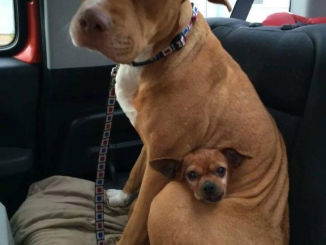
Amidst the chaos and demands of everyday life, there are those small, precious moments that have the power to make us smile, often when we least expect it. These moments serve as reminders of our fondest memories, cherished friendships, or beloved pets. Recently, a heartwarming photograph captured one such moment, spreading joy and warmth across the internet.

The image depicts a young boy carrying his loyal dog to the market early in the morning. This simple act touched the hearts of many and prompted an outpouring of positivity, accumulating up to 17,000 likes and hundreds of heartfelt comments.

Bui Tu Anh, a viewer of the photograph, was transported back to his own childhood memories as he gazed at the image. He reminisced about his spacious garden, where he raised dogs, cats, rabbits, and chickens. The sheer joy of nurturing these animals and spending carefree moments with them was enough to create lasting, beautiful memories.
The photograph’s magic lies in the dog’s endearing gesture of wrapping its forelimbs around its owner, a gesture that melts the hearts of all who see it. Perhaps, the boy is too young to understand his pet’s fear of falling, but he knows the remedy lies in holding his furry friend close as they journey together on the bike.

The photographer behind this heartwarming image, Ngan Ha, shared her story. She had visited Don Market in Phu Binh, Thai Nguyen, and encountered this scene that touched her deeply. Being an animal lover herself, she couldn’t resist capturing this special moment. She added, “I have pet dogs at home, so whenever I see a dog, I connect with it. This boy reminds me of my own childhood.”

To Ngan Ha’s surprise, her hastily taken photos at the market resonated strongly with the online community, sparking conversations and nostalgia about youthful memories with family pets.
The charming image of the boy and his loyal companion on their market adventure reignited the fond memories of countless people who had grown up with beloved pets. They recalled the times when pets were like family members, accompanying them on village adventures, or patiently sitting in carts with three-wheel platforms.

Sharing their stories, readers fondly remembered their own pets and their unique quirks. From daring bicycle rides with dogs to cats eagerly awaiting their owners at the school gate, these tales of companionship and love filled the comments section.
One commenter, Suy Huynh, even humorously pledged to save money and raise Pitbulls to spend their lives together in blissful companionship.
Today, pets are more than just animals; they provide companionship, emotional support, and reduce feelings of loneliness and stress. They boost self-esteem and bring forth positive emotions, especially in children. While many consider their pets as family members, there are situations where the human-animal relationship becomes strained, leading to pet abandonment. Various reasons, such as lack of time, financial hardship, unexpected litters, family dynamics, or changes in the household, can result in this unfortunate outcome.

However, the experience of abandoned animals on the streets varies greatly. Some are fortunate enough to find new loving homes, while others face a harsher fate. The challenges and outcomes these animals encounter serve as a poignant reminder of the importance of responsible pet ownership and the need to support animal welfare initiatives.
The moment the heroic rescue team valiantly battled against the clock to liberate the unfortunate dog trapped in the underground bunker left everyone overwhelmed with emotions
In a heart-pounding rescue operation, a dedicated team of heroes faced a race against time to free Ziggy, a 10-year-old Patterdale terrier, from a perilous underground bunker. This harrowing ordeal left everyone on edge as they fought tirelessly to save a beloved pup trapped in a dire situation.

Ziggy had been enjoying a carefree day on his family’s farm, frolicking alongside his mom when an unexpected turn of events sent him spiraling into a dark abyss—an underground drain pipe. At first, his mom wasn’t overly concerned; after all, this wasn’t Ziggy’s first escapade into subterranean exploration. But as the minutes turned into hours, and Ziggy failed to reappear, panic set in.

Lauren Flintoft, Ziggy’s mom, shared her worry, saying, “I was worried he might have been stuck, and that’s why he didn’t appear. My husband Tim spent the whole night trying to entice him out, and when he didn’t emerge, I called in help.”
Desperate for aid, Flintoft reached out to the RSPCA (Royal Society for the Prevention of Cruelty to Animals) with hopes that they could assist in rescuing Ziggy from his precarious predicament. A team of dedicated rescuers promptly arrived at the scene, ready to tackle the daunting task of locating and liberating the trapped terrier.

The operation was not for the faint of heart. Rescuers had to meticulously map the complex underground pipes, meticulously plotting their course to reach Ziggy. With unwavering determination, they began to dig two enormous holes, strategically positioned to expose Ziggy’s location.
Finally, after hours of relentless effort, the group spotted a glimmer of hope—a glimpse of Ziggy’s furry form within the confined space. With great care and precision, they gently cleared away the debris that held Ziggy captive, allowing him to wiggle his way to freedom. Remarkably, Ziggy had endured an astonishing 19 hours trapped in the drain pipe.
Despite his extended ordeal, Ziggy emerged from his subterranean prison unharmed, albeit a bit shaken. He was swiftly reunited with his relieved family, basking in the warmth of their embrace. This heartwarming rescue reaffirmed the unwavering bond between humans and their faithful canine companions.

Faebian Vann, an animal collection officer with the RSPCA, joyfully shared, “He’s now back home with his owners where he belongs, and no doubt he’ll be getting up to no good again very soon.”
Ziggy’s triumphant return serves as a testament to the extraordinary efforts of a dedicated rescue team and the power of compassion in the face of adversity. His story reminds us of the enduring spirit of our four-legged friends and the lengths we’re willing to go to ensure their safety and well-being.



Leave a Reply